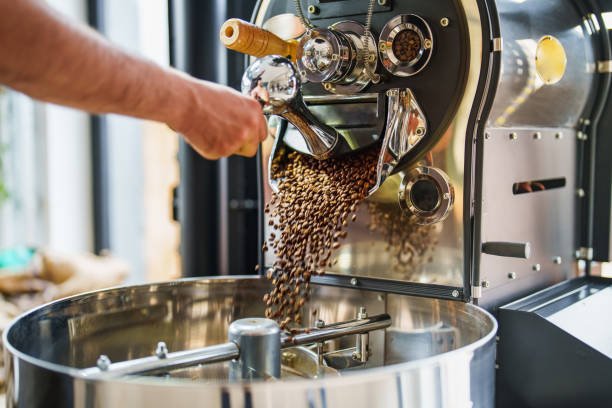Embark on a journey that delves deep into the aromatic world of coffee as we uncover the exquisite art of roasting coffee beans. Roasting, the transformative process where humble green beans evolve into flavorful treasures, is more than just a step in coffee production—it’s an alchemical dance that determines the essence of your brew. The pivotal role roasting plays in shaping the flavor profiles we savor with each sip cannot be overstated; it’s where raw potential meets skillful finesse to bring forth a symphony of taste sensations.
Table of contents

Within the cracks and pops of roasting machines lies a universe of possibilities waiting to be explored by coffee enthusiasts, homebrewers, and DIY aficionados alike. As temperatures rise and hues change from verdant green to chestnut brown, so too do intricate flavors unfurl. Understanding the significance of each stage—be it yellowing, first crack, or beyond—provides insight into how variances in time and heat can coax out nuances ranging from bright acidity to velvety smoothness in your cup. It’s here, amidst swirling scents and roasted perfection, that the magic of coffee truly reveals itself—a craft both ancient and ever-evolving. Join us as we demystify this enchanting process, giving you newfound appreciation for what lies behind your morning brew.
Understanding Coffee Roasting
Coffee roasting is a delicate craft that transforms green coffee beans into the aromatic and flavorful beans we brew. The journey of a coffee bean through roasting involves distinct stages. Initially, during the ‘yellowing’ phase, the beans lose moisture and start to develop their flavor profile. As the heat intensifies, the beans undergo ‘first crack,’ signifying the release of trapped gases within, which creates audible cracks akin to popcorn popping. Subsequently, in the ‘caramelization’ stage, sugars caramelize, deepening the flavors.
Temperature and time are crucial factors in determining the flavor outcomes of roasted coffee. A longer roast at high temperatures can result in a dark roast with notes of bitterness and smokiness, while a shorter duration at lower temperatures might yield a lighter roast with floral or fruity undertones. Additionally, essential oils within coffee beans play a vital role in flavor development. These oils are volatile compounds released during roasting that imbue coffee with its characteristic aroma and taste.
Imagine this process as an orchestra where each note (temperature) played with precise timing influences how rich or bright the symphony of flavors will be. It’s this intricate dance between heat and time that brings out the nuances in your morning cup of joe—a balance where too little heat leaves tastes underdeveloped and too much creates a harsh bitterness. Embrace this alchemy of flavors as you explore different roast profiles to discover your perfect brew.
Types of Roasts
When it comes to coffee roasting, the different types of roasts play a significant role in determining the flavor profile that ends up in your cup.
Light roasts
Light roasts are characterized by their light brown color and higher acidity levels. These roasts often preserve the unique characteristics of the coffee bean origins, bringing out bright and fruity notes. For example, a light roast Ethiopian Yirgacheffe might exhibit floral aromas with hints of citrus.
Medium roasts
Moving on to medium roasts, these beans are roasted slightly longer than light roasts but before reaching the dark roast level. Medium roasts strike a balance between acidity and body, offering a more rounded flavor profile. A Colombian medium roast could showcase nutty undertones with a mild fruity sweetness—a versatile choice loved by many for its approachable taste.
Dark roasts
Dark roasts take on a rich, almost black appearance due to prolonged exposure to heat during the roasting process. These beans have lower acidity levels compared to lighter counterparts and often feature bold, smoky flavors with caramelized notes. Picture a dark roast Sumatra Mandheling delivering a deep, earthy experience with a lingering bittersweet finish.
Selecting the right roast for your palate boils down to personal preference—whether you savor the crisp acidity of a light roast, seek the richer nuances of a medium roast, or prefer the robust intensity of dark-roasted coffee. Experimenting with various types of roasts allows you to uncover your favorite flavor profiles and tailor your brewing experience to suit your taste buds perfectly.
At-Home Roasting Techniques
For those eager to dive into the world of home coffee roasting, there are several methods to choose from depending on your preferences and equipment. One popular method is using an air popper, typically repurposed from its original use in making popcorn. The hot air circulation within the machine evenly roasts the beans, offering a consistent result. Alternatively, some enthusiasts opt for oven roasting, where beans are spread on a tray and heated at a specific temperature. This technique gives good control over the roast level. Stovetop roasting, reminiscent of traditional methods, involves a skillet or pan to gently roast small batches of beans.
Step-by-step guide
Let’s explore a step-by-step guide on how to roast coffee beans at home using one of these preferred methods—for instance, stovetop roasting. Start by heating the skillet on medium heat before adding your green coffee beans. Continuously stir the beans to avoid scorching while allowing them to roast uniformly. As they progress through the various stages of browning, listen for distinctive crackling sounds signaling first crack and continue roasting until you achieve your desired level of roast. Once roasted to perfection, cool the beans promptly to halt the roasting process and preserve their flavors.
Each home roasting technique offers a unique experience in controlling the roast development and flavor profile of your coffee beans. Experimenting with different methods allows you to tailor your roast precisely to match your taste preferences. Whether you prefer the convenience of an air popper or enjoy the hands-on approach of stovetop roasting, mastering these techniques can elevate your coffee brewing journey and unlock a whole new realm of aroma and flavor possibilities right in your kitchen.
Flavor Development Secrets
When it comes to the world of coffee roasting, understanding the secrets behind flavor development can elevate your homebrewing game. The journey from green beans to a perfect cup of coffee is a complex dance of chemical reactions influenced by various factors. Factors like roasting temperature, duration, and even the origin of the beans play crucial roles in shaping the final flavor profile.
As the coffee beans undergo roasting, key characteristics such as acidity, body, and aroma are developed. Acidity refers to the perceived sharpness or brightness in coffee – ranging from lively citrus notes to smooth, mellow tones. Body relates to the weight and texture of the brewed coffee on your palate – whether it feels light like tea or heavy like cream. Aroma encompasses the delightful scents that waft from your cup, ranging from floral and fruity to nutty and chocolatey undertones
Different roast levels.
To unlock a world of flavors, consider experimenting with different roast levels. Lighter roasts tend to retain more of the bean’s original characteristics, offering vibrant acidity and floral notes. Medium roasts strike a balance between acidity and body, showcasing caramel sweetness and nuanced flavors. Dark roasts bring out bolder profiles with rich body and intense smoky notes. By sampling various roast levels, you can hone in on your preferred flavor spectrum – be it bright and acidic or bold and robust.
In your quest for the perfect cuppa, don’t be afraid to customize your roast level preferences based on varietals or blends you’re working with. Embrace the artistry of coffee bean roasting by adjusting parameters like temperature gradients during roasting sessions; explore how subtle changes can lead to entirely new flavor dimensions in your morning brews. Remember: It’s not just about brewing a cup; it’s about crafting an experience that tantalizes your senses at every sip.
Coffee Bean Storage Tips
Proper storage of freshly roasted coffee beans is crucial to preserving their flavor and aroma. After the roasting process, coffee beans release carbon dioxide, which can negatively impact the taste if not allowed to escape. To maintain freshness post-roasting, it’s essential to store them in a container with a one-way valve that allows CO2 to exit without letting oxygen in. Oxygen exposure can lead to oxidation, degrading the quality of the beans.
The best practices for storing roasted coffee beans include keeping them away from moisture, light, heat, and air. Storing them in an airtight container in a cool, dark place like a pantry or cupboard helps extend their shelf life. Avoid transferring the beans into clear containers or leaving them exposed on countertops as light can deteriorate their flavors over time. Additionally, refrain from storing coffee near spices or other strong-smelling foods as they can absorb odors.

Common mistakes
Common mistakes when storing freshly roasted coffee beans include freezing or refrigerating them. Contrary to popular belief, exposing coffee beans to cold temperatures can cause moisture accumulation when taken out of the freezer or fridge, leading to flavor degradation. It’s recommended to consume freshly roasted coffee within two weeks for peak flavor but if needed for longer-term storage (up to a month), opt for vacuum-sealed bags placed in a cool area away from direct sunlight. By following these storage tips diligently, you can savor the rich flavors and aromas of your favorite brews long after roasting.
Exploring Unique Roasting Methods
For coffee aficionados seeking to elevate their home roasting game, exploring unique methods beyond the conventional can unlock a world of flavors. Two distinct techniques that stand out in the realm of artisanal coffee roasting are drum roasting and fluid bed roasting. Drum roasting involves using a cylindrical drum that rotates over heat, providing an even roast by constantly agitating the beans. On the other hand, fluid bed roasting suspends the beans on a stream of hot air, ensuring uniform heating and efficient chaff removal for a cleaner roast.
Drum roasting
Each method comes with its own set of benefits and challenges. Drum roasting, known for its traditional approach, allows for greater control over temperature and roast consistency. This method is favored for its ability to produce well-balanced flavors through careful monitoring of heat application.
Fluid bed roasting
Conversely, fluid bed roasting is celebrated for its rapid roast times and precise control over airflow, resulting in coffees with bright acidity and pronounced aromatics. However, beginners may find it challenging to master the subtleties of this technique compared to drum roasting.
Enthusiasts looking to delve into unique roasting methods should consider experimenting with both drum and fluid bed approaches to understand their nuances fully. By rotating between these methods based on the desired flavor profiles or coffee bean varieties, homebrewers can expand their repertoire and discover new dimensions in their brewing journey. Whether aiming for a light roast highlighting floral notes or a dark roast accentuating deep chocolate undertones, embracing diverse roasting techniques adds depth and creativity to one’s craft as a coffee connoisseur.
Guidelines for Optimal Extraction
To truly savor the flavors locked within your freshly roasted coffee beans, understanding the nuances of extraction is key. The grind size plays a crucial role in this process. Picture this: coarser grinds are like steeping tea, while finer grinds resemble cooking spices in a stew. Experiment with different grind sizes to see how they affect the final taste in your cup.
Equally important is getting the water-to-coffee ratio just right. Think of it as conducting a symphony – when balanced correctly, each note harmonizes perfectly. For a balanced extraction profile, aim for around 1:16 ratio of coffee to water. This sweet spot allows you to tease out the intricate flavors from your carefully roasted beans without overwhelming them.
Now, let’s talk brewing tips tailored to specific roast levels for an exquisite drinking experience. Light roasts deserve gentler treatment – opt for pour-over methods or delicate drip machines to highlight their bright acidity and floral notes. For medium roasts, consider espresso-based drinks that enhance their smooth body and caramel undertones. Dark roasts shine through in French presses or cold brews, showcasing their robust nature and bittersweet finish. By aligning your brewing techniques with the roast level, you can unlock a myriad of flavors waiting to be discovered in every cup.
Conclusion
Mastering the Art of Coffee RoastingIn this journey to uncover the art of roasting coffee beans, we’ve delved into the intricacies of different roast levels, explored at-home roasting techniques, and demystified the factors influencing flavor development. Remember, from determining the perfect grind size to selecting a roast that suits your taste buds, each step in the roasting process can significantly impact your coffee experience.
As you embark on your own roasting adventures, don’t be afraid to experiment with various methods and roasts. Embrace the nuances of light, medium, and dark roasts; discover unique roasting techniques; and fine-tune your brewing parameters to truly master the art of coffee roasting. By immersing yourself in this craft and exploring your palate preferences further, you’ll not only elevate your coffee game but also unlock a world of flavors waiting to be savored. Get ready to savor every sip of coffee as you dive deeper into the captivating realm of roasting – an art that blends science, creativity, and passion seamlessly.






